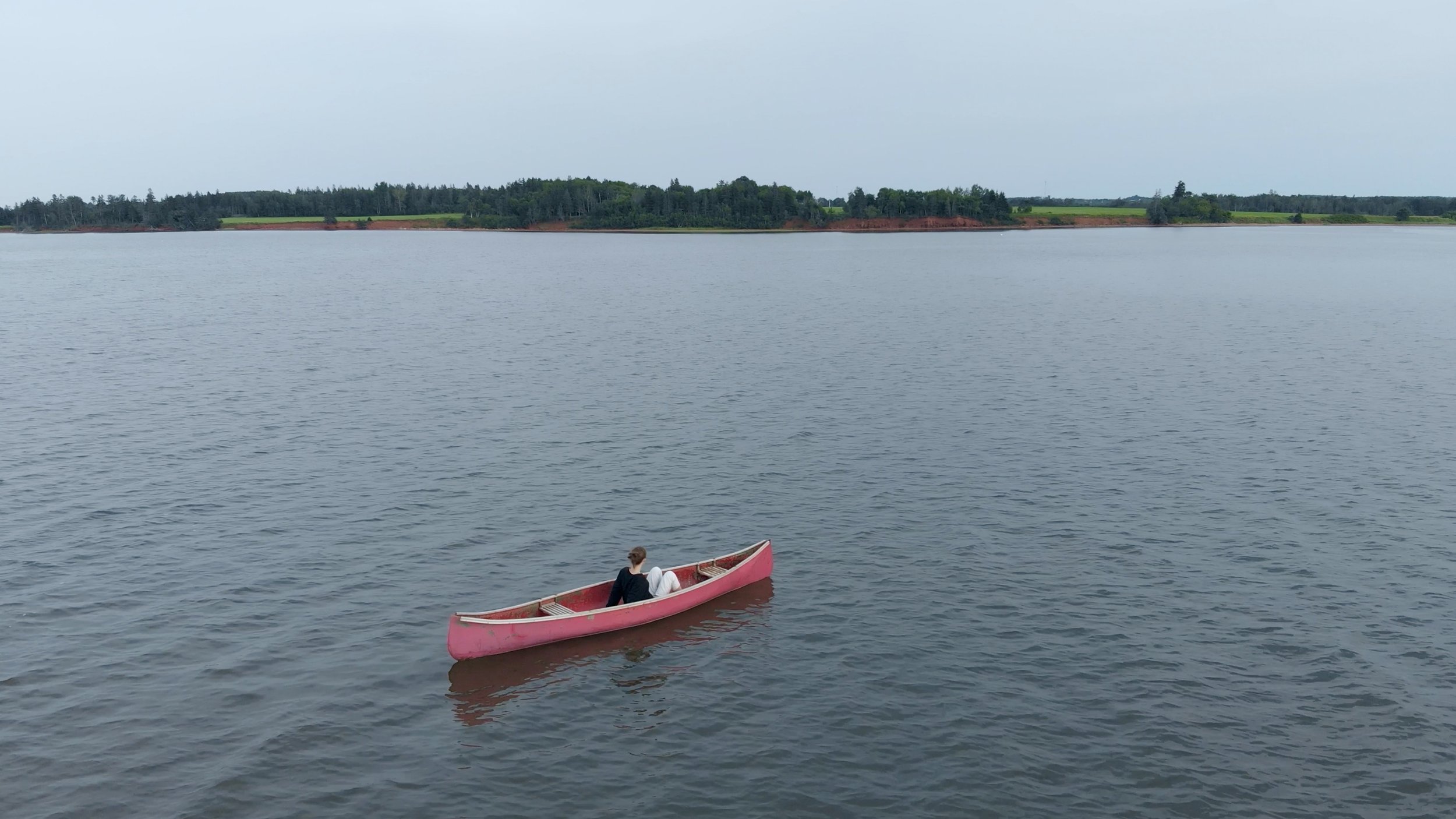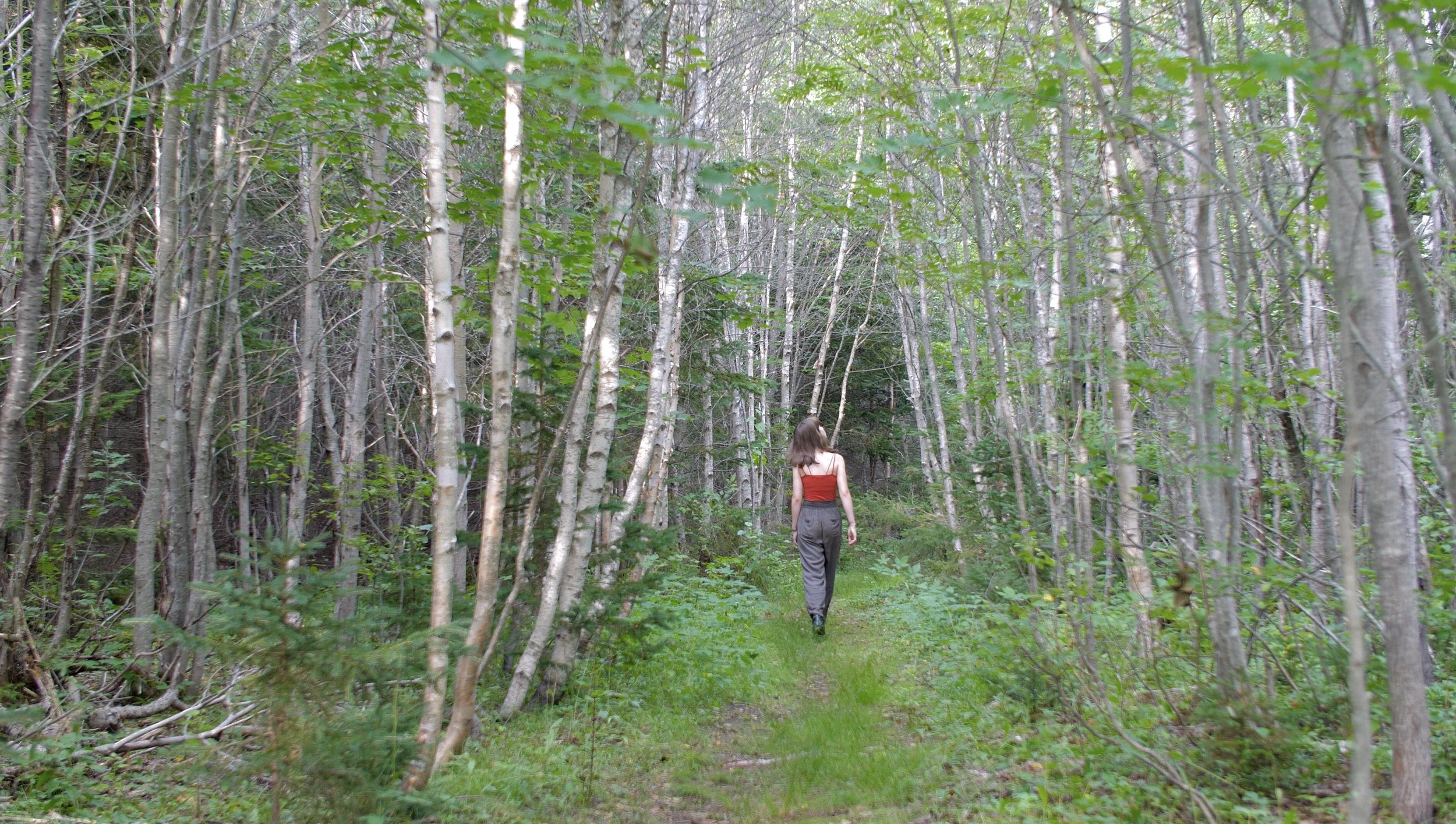My Senior Thesis Film had been a project I’d been looking forward to and planning for about a year. It began with a feeling of overwhelming anxiety, especially from Covid-19, and a longing to get out of the city and into nature.

The very first image I had in my head, even before the concept, was of someone being stranded in the middle of a body of water. This could have been subconsciously influenced by a Taylor Swift music video, in which she’s playing a grand piano floating in deep waters during a storm, but probably also from my newfound love for droning. For so long I had been terrified of flying a drone, because of the possibility of crashing, but with the help of my avid drone-flying boyfriend at the time, I was able to learn and practice while being somewhat guided. I knew I wanted to fly the drone for this film, and use all the equipment I had to my advantage, and so I began thinking of ways in which the drone served a more solid purpose within the film’s overall meaning.
I then began creating visuals in my mind that intrigued me, or evoked a strong emotion that I could relate to. This is where my love for nature came in, and perhaps my missing my cottage. I wanted my film to be filled with images of nature, as diverse as I could find, mostly because I have a passion for exploring new places. Having done much research on locations in California, Ontario (Canada), and Prince Edward Island, the beauty and appeal of a new place won me over in the end. My mom had just recently moved to Prince Edward Island, Canada, so there was a perfect opportunity to explore the land for a few weeks to then figure out where I wanted to shoot my film.
The next step was developing the concept. Aquaphobia was to be a visual metaphorical translation of what it means to overcome stress and gain control of your mind. I knew that nature would play a huge role in the meaning of my film, I just needed to figure out how. At the time of pre-production, I had been working on a project with a friend of mine who studies contemporary modern dance. This gave me the idea to incorporate dance within nature, and give it a meaning that could relate to my own life. The idea of dancing in nature became a metaphor for the act of temporarily escaping reality to find peace within your own mind. I then thought of all possible places I would like to dance, and realized one cannot dance in deep water! So, water would be a perfect metaphor for the anxiety-ridden mind. I became excited when thinking about the colloquial term “drowning in work” and how it could translate to the screen with my character “drowning in her thoughts and fears” quite literally in a body of water, with the possibility of drowning.
People would ask me, “Why can’t she just swim to shore?” and I told them she is too far, but to avoid confusion about the story, I would title my film “Aquaphobia”. This word would give people an idea of the film before watching it, while still being vague enough to excite curiosity. At first, some might have taken the word literally, but I was hoping to deliver a story more unexpected, and suggest an alternate meaning of the word.
Logline: A young girl with a fear of water is mysteriously stranded in the middle of the bay. To find safety, she must use her imagination and change her state of mind.
Creating a shot list for my concept was one of the more challenging aspects of pre-production. I’m the type of person who has a hard time making decisions, and when creating films, I for-see so many possibilities in terms of how to visually represent each scene. I made a draft of the framing, techniques, and angles for every scene, and it took me about a month of playing it all back in my head to come to a more precise shooting plan. This decision was also made after a better understanding of how much time I had to shoot at each location, how many people were helping me, an honest assessment of my production skills, and of course my budget. While I didn’t choose to include all my favourite shots, it was a decision that had to be made in order to facilitate the overall production process. I believe that finding this balance did indeed set me up for more success on set, and allowed me to get 90% of the shots within the planned timeframe.
Something I wished I had prepared better for was learning how to use the DJI Ronin S gimbal that I rented on the island. Instead of testing it out the day of the shoot, I should have taken the time to do so the day before, even if it would have costed me more money. I learned a lot from producing this film, as well as how important it is to do research beforehand. What I was mostly thankful for was my mom’s family friend lending us their canoe and helping as production assistant last minute. Shooting the water scenes was especially challenging for everyone, whether it was the consistent manoeuvring of the canoe against the slight current, yelling ‘action’ and my actress being too far to hear, or slowly running out of time and stressing about not getting all the necessary shots. I would not recommend filming in moving water unless you have a lot of time on your hands!


Filming on land was probably the best couple of days I had that entire year. Not only was I in new and exciting environments – I was doing what I love. I ended up experimenting a lot with shooting, as well as directing. My original actress/dancer missed her flight the day before the scheduled shoot, but my step-sister was staying with us and offered to fill in. I was shocked at how quickly she adapted and was able to understand the story and my vision. She was very enthusiastic to help out and it was a comfort to know that there was still hope for my film to happen on schedule, after so much planning! Having not studied dance, and with her theatre experience, she acted and danced with so much professionalism, grace, and ease, and her unique personality really shone through. After playing back the footage, I could not have pictured my film any other way – she was exactly what the story needed.







Post-production of this film was very exciting. I never got sick of seeing the same images over and over, because nature can never bore me. Not to mention I still had some freedom in terms of choosing the best shots to create a cohesive dance sequence. What I had planned on doing before shooting the film was writing my own piano composition, but ultimately the stress of graduating and keeping up with all my other classes made this difficult. I happened to tell someone I had met briefly before about my film, and he told me he was studying music composition and scoring. The timing couldn’t have been more perfect, and so I asked if he would look at my rough cut and put something together. After a few discussions of the overall mood and tempo, and a couple revisions, the end result had me falling in love with the dancing sequence all over again. His stunning and intriguing composition elevated the beauty of nature and my dancer, and provided a better contrast between the gloomy water scenes.
What I want people to feel after watching this film is hope that in their own way they can create a safe space to go to when dealing with stress or intrusive thoughts. In my film, that space is in the mind, but I encourage everyone to explore physical spaces too. I believe that a majority of life is spent in our heads, and that being able to control our emotions is crucial to our well-being, as well as beneficial for our growth.
